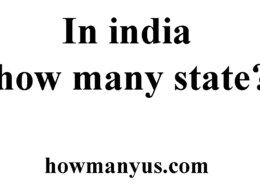In india how many state?
The question “In India, how many states?” pertains to the administrative divisions within the country of India. India is a federal union comprising states and union territories, each with its own government and administrative structure.
As of my last update, India consists of 28 states and 8 union territories. The states are the primary administrative units with their own elected governments and legislatures. Each state has varying levels of autonomy and authority over its internal affairs, including governance, education, health, and law enforcement.
The concept of states in India emerged after independence in 1947, as the country reorganized its administrative divisions based on linguistic and cultural considerations. Over the years, the number of states has increased through state reorganization and the formation of new states to accommodate regional diversity and demands.
In india how many state?
Understanding the number of states in India is important for various purposes, including governance, politics, and geography. Each state contributes uniquely to India’s cultural, economic, and social landscape, adding to the country’s rich diversity and heritage.


In India, How Many States? Understanding India’s Administrative Divisions
The question “In India, how many states?” refers to the number of administrative divisions known as states within the country. India, as a federal union, is comprised of states and union territories, each with distinct governance and administrative responsibilities.
As of my last update, India consists of 28 states and 8 union territories. The states are the primary administrative units of India, each with its own elected government, legislature, and judiciary. The division of India into states was primarily based on linguistic and cultural considerations to accommodate the diverse population and regional identities across the country.
The states of India play a vital role in the governance and development of the nation. They have jurisdiction over various matters, including law and order, education, healthcare, infrastructure, and economic development within their respective territories. States also have the authority to formulate policies and laws tailored to their unique needs and challenges.
The process of state formation and reorganization in India has evolved over time to address regional aspirations and demographic changes. New states have been created through constitutional amendments and legislative acts to accommodate demands for greater administrative autonomy and representation.
Understanding the number of states in India is crucial for various stakeholders, including policymakers, researchers, and students. It provides insights into the country’s political and administrative structure, facilitating informed discussions on governance, federalism, and regional development.
India’s states contribute significantly to the country’s cultural diversity and heritage. Each state has its own distinct language, traditions, cuisine, art forms, and festivals, enriching India’s social fabric and contributing to its vibrant identity on the global stage.
In summary, India comprises 28 states, each playing a unique role in shaping the nation’s socio-economic landscape. The diversity and complexity of India’s states reflect the country’s rich tapestry of cultures, languages, and traditions, making it a fascinating mosaic of unity in diversity.
For further exploration, consider studying the history of state formation in India, the political dynamics of federalism, and the impact of state policies on national development. Delving deeper into India’s administrative divisions enhances understanding of its governance structure and societal dynamics.